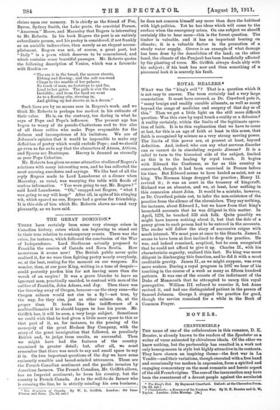NOVELS.
CHANTEMEELE4
THE name of one of the collaborators in this romance, D. K. Broster, is already known to the readers of the Spectator as a writer of verse animated by chivalrous ideals. Of the other we know nothing, but the partnership has resulted in a work not only homogeneous in style but highly attractive in its contents. They have chosen an inspiring theme—the first war in La Vendee —and their variations, though executed with a free hand and occasionally too modern in expression, form a spirited and engaging commentary on the most romantics and heroic aspect of the old French regime. The core of the insurrection may have been the resentment of a devout people against the secularist * The King's Broil By Raymond Crawford. Oxford: at the Clarendon Press. [8s. 6d. net.] t Chantemerle : a Romance of the Vendean War. By D. IL Broster and G. W. Taylor. London: John Murray. [68.] intolerance of the Republic, and the first leaders of the revolt were peasants or small traders. But in the Vendee at least feudalism was shorn of its oppression and insolence, the relations between landlords and tenants gave little ground for complaint, and when the peasants appealed to the nobles to head the insurrection the summons was right nobly answered. But though we get more than a passing glimpse of Henri de la Rochejacquelein and other of the intrepid commanders of the great " Royal and Catholic " Army, Messrs. Broster and Taylor adopt the judicious method followed by the greatest writers of historical romance ; that is, they assign the leading parts in their story to imaginary personages, while keeping the historical figures more or less in the background. The principal figures are four in number—two young noblemen of Poitevin Vendee, Gilbert Marquis de Chiteau-Foix and his cousin, Louis Vicomte de Saint. Ermay ; Lucienne d'Auconrt, Gilbert's affianced bride, a lady in waiting to the Princess Elisabeth ; and M. des Graves, the courtier priest, who had buried himself as a village Cure at Chantemerle, where Gilbert lives on his estate with his mother. The story opens in January, 1792, when Louis, who is in attendance on the King, has become entangled in a Royalist-Girondin intrigue, and at the same time has surprised his cousin's fiancee into a declaration of her love for him, Louis. This is natural enough, for Gilbert is a grave, serious young man, while Louis is an irresistible Prince Charm- ing; but Gilbert is such a saint that the lovers cannot bring themselves to deceive him. Meantime Gilbert, distrusting the Girondist overtures, hurries up to Paris to extricate Louis from the entanglement. Matters, however, have gone too far : the Royalists are denounced and Louis arrested. Gilbert effects his release by enlisting the influence of the mistress of a Girondist leader, and carries him off disguised as his valet to his country seat. The perils of the journey, during which Louis receives a dangerous wound in defending his cousin, are vividly described. But while a bond of natural affection leads the cousins constantly to risk their lives for each other, Gilbert's confidence is clouded by suspicion, confirmed by some chance words spoken by Louis in his delirium, and they are only kept from an open breach by the outbreak of the revolt, in which they fight side by side to the end. For Gilbert, hitherto a moderate and a Liberal, has become infected by the example of the intrepid Vendeens and takes his place in the forefront of the insurrection. Before the story ends the cousins have been reconciled, all misunderstandings cleared up, and the love problem solved by a tragical denantent.
The book is long, but it is very well written and informed by a genuine enthusiasm. Lucienne is a graceful rather than interesting figure, but the two cousins are happily contrasted, and the portrait of the Cure, a crypto-Cardinal as he turns out, is a striking study of conflicting ideals. There is no lack of incident and excitement in the narrative, but the prevailing temper is one of a somewhat =lie sentiment.



































 Previous page
Previous page